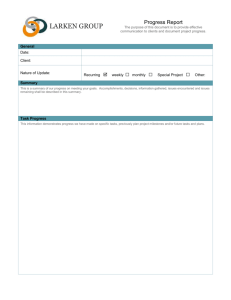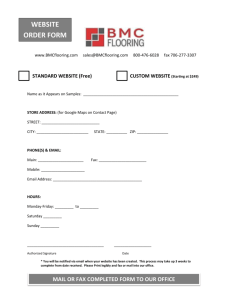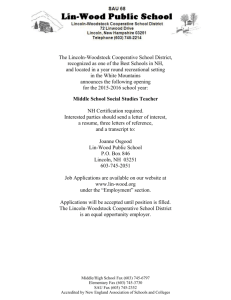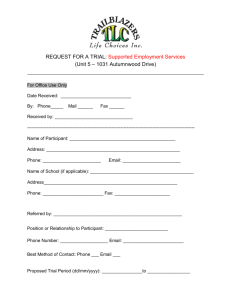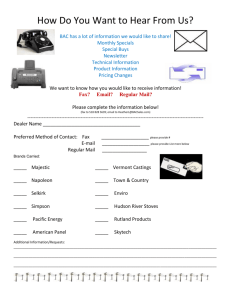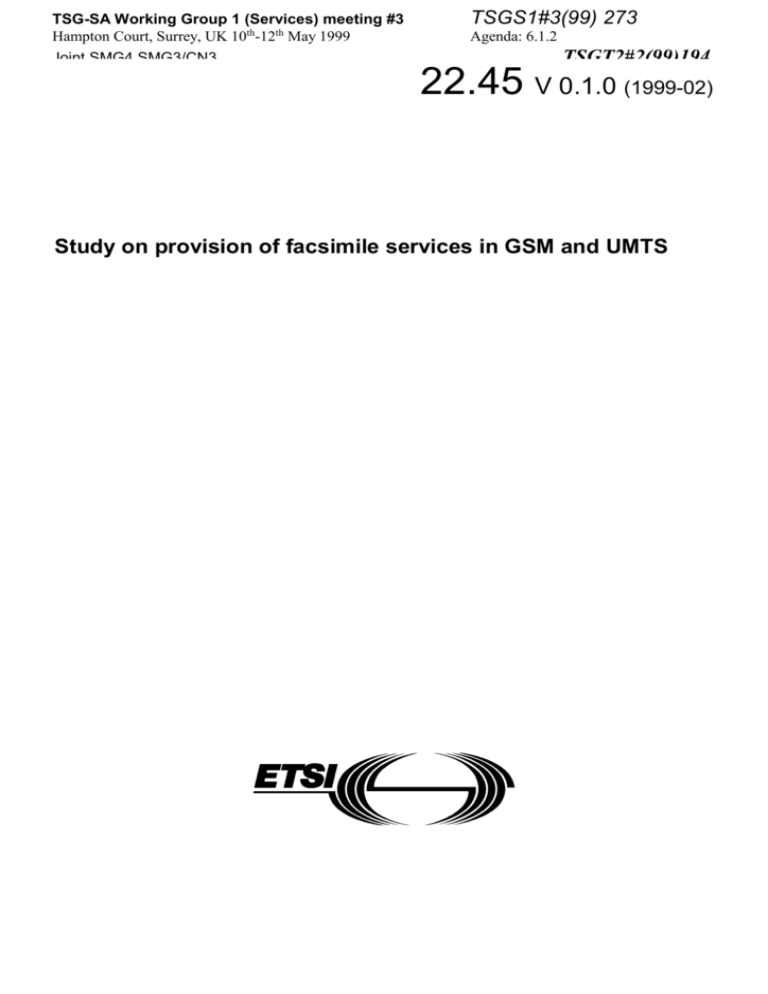
TSG-SA Working Group 1 (Services) meeting #3
Hampton Court, Surrey, UK 10th-12th May 1999
Joint SMG4,SMG3/CN3
London, UK
March, 15th-19th, 1999
TSGS1#3(99) 273
Agenda: 6.1.2
TSGT2#2(99)194
22.45 V 0.1.0 (1999-02)
Study on provision of facsimile services in GSM and UMTS
2
22.45 V 0.1.0 (1999-02)
Reference
WI 238
Keywords
Facsimile, Mobile Networks, Messaging
ETSI
Postal address
F-06921 Sophia Antipolis Cedex - FRANCE
Office address
650 Route des Lucioles - Sophia Antipolis
Valbonne - FRANCE
Tel.: +33 4 92 94 42 00 Fax: +33 4 93 65 47 16
Siret N° 348 623 562 00017 - NAF 742 C
Association à but non lucratif enregistrée à la
Sous-Préfecture de Grasse (06) N° 7803/88
Internet
secretariat@etsi.fr
http://www.etsi.fr
http://www.etsi.org
Copyright Notification
Reproduction is only permitted for the purpose of standardization work undertaken within ETSI.
The copyright and the foregoing restrictions extend to reproduction in all media.
© European Telecommunications Standards Institute 1999.
All rights reserved.
ETSI
3
22.45 V 0.1.0 (1999-02)
Contents
Intellectual Property Rights ................................................................................................................................ 4
Foreword ............................................................................................................................................................ 4
Introduction ........................................................................................................................................................ 4
1
Scope ...................................................................................................................................................... 4
2
References .............................................................................................................................................. 5
3
Definitions, symbols and abbreviations ................................................................................................... 5
3.1
Abbreviations ..................................................................................................................................................... 5
4
Requirements ........................................................................................................................................... 6
5
Business Model ........................................................................................................................................ 6
6
Store and Forward Facsimile (T.37) ........................................................................................................ 7
6.1
6.2
6.2.1
6.2.2
6.2.3
6.2.4
6.2.5
7
7.1
7.2
7.2.1
7.2.2
7.2.3
7.2.4
7.2.5
8
8.1
8.2
8.3
8.4
8.5
8.6
Description......................................................................................................................................................... 7
Application in UMTS and GSM ........................................................................................................................ 7
Architecture .................................................................................................................................................. 7
Mobile Originated ........................................................................................................................................ 8
Mobile Terminated ....................................................................................................................................... 9
Handover Procedures ................................................................................................................................... 9
Roaming ....................................................................................................................................................... 9
Real Time Facsimile (T.38) ................................................................................................................... 10
Description....................................................................................................................................................... 10
Application in UMTS and GSM ...................................................................................................................... 10
Architecture ................................................................................................................................................ 10
Mobile Originated ...................................................................................................................................... 11
Mobile Terminated ..................................................................................................................................... 11
Handover Procedures ................................................................................................................................. 12
Roaming ..................................................................................................................................................... 12
Integration of Services ........................................................................................................................... 12
Combining T.37 and T.38 based solutions ...................................................................................................... 12
Combining Fax with a Short Message Service, SMS ....................................................................................... 12
Combining Fax with Mailbox-Service ............................................................................................................. 13
Combining Fax with WWW or WAP .............................................................................................................. 13
Combining Fax and HLR functionality ............................................................................................................ 14
Integrating Fax within a Multimedia Message Service, MMS ......................................................................... 14
History .............................................................................................................................................................. 16
ETSI
4
22.45 V 0.1.0 (1999-02)
Intellectual Property Rights
Foreword
Introduction
Currently in GSM, there are two facsimile services specified: teleservice TS61 "Alternate speech/facsimile G3" and
TS62 "Automatic facsimile G3". These two services utilise the T.30 [2] protocol between the mobile station and the
facsimile machine at the other end. . Both services exist in two modes, transparent (acc. GSM TS 03.45) and nontransparent (acc. GSM TS 03.46). Although the transparent modeis designed to be transparent to the network,
intervention of the IWF is needed whenever this service is used. The reasons for this are explained in GSM TS 03.45 [6]
and are briefly summarised below:
The GSM speech bearers are not adequate for transporting the modulated information transmitted between the fax
machines. A data bearer must be set up between the IWF and the MS and the IWF must convert the modem signals
to digital form as for all modem services.
Not all messages defined in the T.30 protocol are applicable in the mobile case. The IWF must filter the messages
sent from the facsimile machine in the fixed network.
Fall back messages require that a different rate adaptation is applied on the mobile leg or that a different channel is
used
High failure rates depending on the equipment used are often experienced. This is mainly due to the high error rates on
the radio interface and to long transmission delays. Different manufacturers have implemented various procedures to
handle these problems, but due to the large variety of facsimile machines used in the fixed network and their various
implementations of the T.30 protocol, it is not possible to guarantee acceptable performance. The cost experienced by
manufacturers for development, trouble shooting and maintenance related to the facsimile services is high. Alternative
ways of transmitting facsimile messages to and from mobile users need to be investigated.
In contrast to the quality provided by the transparent mode, the quality provided by non-transparent mode is much better
provided that the bit error rate is low. However, for bit error rates exceeding a certain threshold it is not possible at all to
transmit a facsimile document and the transmission results in the following behaviour. The sending Fax equipment
expects the acknowledgement on the partial page within a certain time frame. The RLP entity of the receiver delivers the
first part of a T.30 partial page without any error to the receiving Fax equipment. Due to the RLP retransmissions the
receiving Fax equipment is not able to send the acknowledgement in time. Therefore the sending Fax equipment aborts
the transmission of the document.
The aim of this report is to show that alternative solutions exist. Given that most of the problems experienced today can
be traced to the termination of the T.30 in the mobile station, the alternative solutions described in this report, which
have initially been developed for usage in the Internet, will all be based on terminating the T.30 protocol in the network
and using some alternative transmission method to and from the mobile user.
In addition to the development problems listed above, one may argue that the GSM facsimile services TS61 and TS62
are not appropriate. Mobile terminated facsimile calls are rare, because the mobile user equipment is seldom ready to
accept such calls. Also, most user equipment do not allow the user to switch between speech and facsimile mode, which
implies that the alternate facsimile/speech service is almost not used. This argument applies to both modes of
transmission, transparent and non-transparent.
This report studies the applicability of two particular protocols: T.37 [3] and T.38 [4] which in turn are based on many
IETF RFCs. It does not intend to express any preference for one or the other as both can be applied. They may be
integrated either together or separetely with already established GSM/Internet specific services.
Although this report is the result of a UMTS work item, it is intended to be applied to GSM as well, thereby increasing
the interoperability between UMTS and GSM networks.
1
Scope
This document gives guidance on how facsimile services can be provided in a GSM or UMTS network. It studies how
facsimile messages can be exchanged between mobile equipment and a PSTN facsimile machine. Although the
approaches described herein can be applied to cases where none of the end points are connected to a PSTN, the study of
such cases are out of the scope of this document.
The Scope shall not contain requirements.
ETSI
5
2
22.45 V 0.1.0 (1999-02)
References
The following documents contain provisions which, through reference in this text, constitute provisions of the present
document.
References are either specific (identified by date of publication, edition number, version number, etc.) or
non-specific.
For a specific reference, subsequent revisions do not apply.
For a non-specific reference, subsequent revisions do apply.
A non-specific reference to an ETS shall also be taken to refer to later versions published as an EN with the same
number.
[1]
ITU-T Recommendation F.185:”Internet Facsimile: Guidelines for the support of the
communication of Facsimile Documents”
[2]
ITU-T Recommendation T.30: “Procedures for document facsimile transmission in the general
switched telephone network”
[3]
ITU-T Draft New Recommendation T.37: “Procedures for the transfer of facsimile data via store
and forward on the internet”
[4]
ITU-T Draft New Recommendation T.38: “Procedures for real time group 3 facsimile
communication between terminals using IP networks”
[5]
ITU-T Recommendation H.323: “Visual telephone systems and equipment for local area
networks which provide a non-guaranteed quality of service”
[6]
GSM Technical Specification 03.45: “Technical realization of facsimile group 3 transparent ”
[7]
UMTS 21.04: UMTS; Requirements for the support of data services in UMTS
[8]
UMTS 22.00: UMTS; UMTS Phase 1
[9]
draft-ietf-fax-goals-04.txt, available at http://www.ietf.org/
[10]
draft-ietf-fax-eifax-12.txt, available at http://www.ietf.org/
[11]
Wireless Application Protocol (WAP) version 1.0, available at http://www.wapforum.org
[12]
GSM Technical Specification 03.46: "Technical realization of facsimile group 3 non-transparent"
For the benefit of the reader, a large number of IETF Requests for Comments and drafts could be listed here. However,
they are all referenced in the documents listed in this reference list.
3
Definitions, symbols and abbreviations
3.1
Abbreviations
For the purposes of the present document, the following abbreviations apply:
BSS
Base Station System
e-mail
electronic mail
Fax
Facsimile
GGSN
Gateway GPRS Support Node
G-MSC
Gateway MSC
GPRS
General Packet radio Service
GR
GPRS Register
GSM
Global System for Mobile Communication
HLR
Home Location Register
HTML
Hyper Text Markup Language
IETF
Internet Engineering Task Force
IMAP4
Internet Message Access Protocol, version 4
IP
Internet Protocol
ISDN
Integrated Services Digital Network
ISP
Internet Service Provider
ITU
International Telecommunication Union
IWF
Interworking Function
MM
Multimedia Messaging
MMS
Multimedia Messaging Service
MS
Mobile Station
MSC
Mobile Switching Centre
PC
Personal Computer
PDF
Portable Document Format
ETSI
6
PLMN
POP3
PPP
PSTN
RFC
SGSN
SMS
SMTP
TIFF
TS 61
TS 62
UE
UMTS
USSD
UTRAN
VLR
WAP
WML
WWW
4
22.45 V 0.1.0 (1999-02)
Public Land Mobile Network
Post Office Protocol, version 3
Point-to-point Protocol
Public Switched Telephone Network
Request for Comments
Serving GPRS Support Node
Short Message Service
Simple Message Transfer Protocol
Tag Image File Format
Teleservice 61
Teleservice 62
User Equipment
Universal Mobile Telecommunications System
Unstructured Supplementary Service Data
UMTS Terrestrial Radio Access Network
Visitor Location Register
Wireless Application Protocol
Wireless Markup Language
World Wide Web
Requirements
Since this report is not a specification, the requirements listed in this section are provided as guidance to evaluate
facsimile services.
The reader is referred to the documents below for a rather complete list of requirements
ITU-T F.185 [1]
draft-ietf-fax-goals-04.txt [9]
draft-ietf-fax-eifax-12.txt [10]
Also requirements in UMTS 21.04 [7] and 22.00 [8] are applicable.
The following requirements apply specifically to mobile networks:
No or minor implementation impacts on GSM and UMTS
Handover between and within GSM and UMTS shall be possible during the downloading to and uploading from the
mobile equipment of a facsimile message.
Exchange of facsimile messages shall be possible when roaming to other networks.
The access network shall be transparent to the users of the facsimile service, meaning, for instance, that a user may
choose to download a message to a PC attached to a fixed network or to mobile equipment.
5
Business Model
At least three entities may be distinguished that are involved in the provision of the facsimile services described in this
document. First, the PLMN operator provides the access from a mobile user to the IP network. Second the Internet
Service Provider (ISP) provides IP network access. Third, the Facsimile service provider provides the service as an
application running on the PLMN and IP network. (The PSTN operator, could be added to this list, but there is no direct
relationship between the mobile user and the PSTN operator, so this entity is left out here.) One entity may play more
than one provider role, for instance, the PLMN operator may also be the ISP or service provider for an integrated
implementation. However, the purpose of distinguishing the providers here is to better describe which contribution from
each of them is needed for the total provision of the facsimile services. The aim is to show that the facsimile services
may be provided without any specific contribution from the PLMN operator and the ISP. Only if the facsimile service is
integrated with other services such as SMS or within an MMS, as described in more detail in Section 8, will there be
demands on the PLMN.
Since there are several providers involved in the provision of the service, several subscription checks may be needed.
ETSI
7
22.45 V 0.1.0 (1999-02)
6
Store and Forward Facsimile (T.37)
6.1
Description
T.37 defines procedures that enable facsimile data to be transferred using Internet e-mail as a store-and-forward system.
Approved IETF protocols are used for posting, relaying and delivery of documents. This approach does not require any
changes to existing Internet standards or ITU-T recommendations. The model is shown in Figure 1.
Internet e-mail
T.30
Fax
Gateway
Internet
aware Fax
PSTN
IP network
standard
Fax
e-mail
client
Internet e-mail
Figure 1: Store-and-forward fax according to T.37
The gateway (in the IETF RFCs referred to as offramp / onramp gateway) terminates the T.30 facsimile protocol
towards the PSTN. Fax data will be attached to e-mail messages as fax images and forwarded via Internet e-mail. A
standard fax device is only capable of supporting T.30. An Internet aware fax combines the capabilities of a standard fax
device and an e-mail client.
Two modes of operation are specified.
The Simple Mode supports only the transfer of image data.
In addition to that the Full Mode requires the exchange of capabilities and the confirmation of receipt. This is to
emulate the end-to-end nature of fax between sender and receiver known from fixed network fax.
6.2
Application in UMTS and GSM
6.2.1
Architecture
The application of a T.37 based solution in UMTS and GSM requires the installation of gateways that terminate the
T.30 protocol toward the PSTN and that connect the PSTN with the Internet. Since T.37 uses Internet e-mail (e.g.
SMTP) in order to transport fax images attached to e-mail messages, there are no further requirements to the PLMN for
the information transport.
The mobile station needs in addition to Internet access only a TIFF image viewer.
T.37 provides rather a message-based service than a real-time facsimile service according to T.30 or T.38, respectively.
Whereas the T.37 Simple Mode provides only an e-mail interface, the Full Mode is able to provide a facsimile service
with all of the functions known from the fixed network, e.g. the confirmation of receipt.
With the application of T.37 in a PLMN it is possible to provide at the mobile station an unique communication
interface for a lot of services, e.g. electronic messaging, facsimile, voice over IP. Also for network operators it is of
advantage because they are able to provide these services with an integrated server (refer to Section 8).
A general approach of the application of a T.37 based solution is shown in Figure 2.
ETSI
8
22.45 V 0.1.0 (1999-02)
T.30
Internet e-mail (SMTP) with fax image attached (T.37)
MS
GSM BSS
GB
GGSN
SGSN
UE
UTRAN
MS
GSM BSS
IP network
Fax
Gateway
PSTN
standard
Fax
IU
A MSC
Access
Server
Figure 2: General approach for the application of T.37 for the provision of facsimile service in UMTS and GSM
In Figure 2 a call is routed directly from the PSTN to the gateway. It is more reasonable to route mobile terminated calls
via the G-MSC of the PLMN. By doing this
the multi-numbering scheme of GSM could be used for identifying fax calls from the PSTN;
supplementary services could be provided (e.g. call forwarding);
network operator could use already installed fax-mailboxes;
These services and functions are described more in detail in Section 8.
6.2.2
Mobile Originated
A mobile originated facsimile call looks like a set-up of an IP Bearer by the mobile station. The application “facsimile”
is transparent for GSM or UMTS, respectively. The particular handling depends on the used products for e-mail and Fax
Gateway. It could be as follows:
The user starts his e-mail application, writes an e-mail and sends it to the Fax Gateway. For this the e-mail programme
could set-up a connection (e.g. POP3 or IMAP4) to the e-mail server based on the IP Bearer provided by GSM or
UMTS, respectively. The written e-mail provided with the designated receiver’s fax number is then sent to the e-mail
address of the Fax-Gateway.
Depending on the functions of the Fax Gateway the e-mail may contain only plain text or also attachments. Although
T.37 requires only a TIFF format according to RFC 2301 Profile S there are Fax Gateways that support a lot of different
formats for included attachments (e.g. formats of particular office programmes and other file formats like HTML, TIFF,
GIF, PDF, ...).
Fax Gateways expect the designated receiver’s fax number very differently. Some products expect the fax number as
part of their own e-mail address (e.g. remote-printer.info@<fax_number>.iddd.tpc.int). Other products provide own
clients that give the user the possibility to provide the fax number in a separate entry. Those functions are already
included in some PC operation systems. Again other products expect the fax number in an existing field of the e-mail
header (e.g. the subject or alternative recipient field).
The Fax Gateway converts the received e-mail into a facsimile document and sends it via the PSTN/ISDN to the
designated receiver’s fax number. Notifications may be sent back to the e-mail sender.
ETSI
9
Access
Server
UE
22.45 V 0.1.0 (1999-02)
T.37
Gateway
Fax
machine
Est. of IP Bearer
Est. ofmail box access
Send fax data as e-mail
Transfer email
Fax data
conversion
Call establishment
T.30 fax transmission
Figure 3: Transmission of store-and-forward fax, MO
6.2.3
Mobile Terminated
Mobile terminated facsimile calls may be routed either directly to the Fax Gateway or via the G-MSC to the Fax
Gateway. Routing via the G-MSC enables the use of the multi-numbering scheme to identify the call as a facsimile call
and of the supplementary services for such calls (e.g. call forwarding).
The Fax Gateway converts the received facsimile document into an e-mail. It also translates the receiver’s fax number
into the receiver’s e-mail address. The e-mail is forwarded to the e-mail server. The e-mail is stored in the receiver’s
mailbox. The receiver may be informed via the Short Message Service (SMS).
The e-mail with the facsimile document will only be delivered on request by the receiver. The user starts his e-mail
application. The e-mail programme could set-up a connection (e.g. POP3 or IMAP4) to the e-mail server based on the
IP Bearer provided by GSM or UMTS, respectively. A list of received e-mails is provided to the user. The user can
retrieve or forward e-mails.
Fax
machine
T.37
Gateway
G-MSC
Mail box
Ue
T.30 fax transmission
Fax data
conversion
Send email
Est. of IP bearer
Retrieval of e-mail
Figure 4: Transmission of store-and-forward fax, MT
6.2.4
Handover Procedures
The same Fax Gateway is serving the call before and after the handover, which implies that no special procedures are
needed for the support of handover.
6.2.5
Roaming
IP access while roaming is already covered by standard procedures.
ETSI
10
22.45 V 0.1.0 (1999-02)
7
Real Time Facsimile (T.38)
7.1
Description
T.38 [4] is a protocol used to transfer Group 3 facsimile messages in real time over IP networks. It specifies the
messages and data exchanged between facsimile gateways connected via an IP network. The reference model for this
Recommendation is shown in Figure 5.
Internet e-mail
T.30
Fax
Gateway
Internet
aware Fax
standard
Fax
PSTN
e-mail
client
IP network
Internet e-mail
Figure 5: T.38 reference model
The T.38 protocoll is applied between the two gateways, between a gateway and an internet aware fax device, or two
internet aware fax devices. The communication between the gateways and the G3 facsimile terminals is according to
T.30. The call establishment procedures are based on H.323, Annex D [5] and are specified in Annex B of
Recommendation T.38.
In order to apply T.38 to GSM or UMTS, the mobile equipment shall have to play the role of an internet aware fax
device. Only one gateway would be required, placed between the IP network and the PSTN/ISDN. This gateway could
be provided by the PLMN operator or by an independent service provider.
When applying it to GSM or UMTS, T.38 could also be provided together with T.37 and other messaging services. T.37
could be used as a fall-back service if, for instance, the transmission delay between the fax gateway and the mobile
equipment causes problems for the T.38 protocol. T.38 could also be limited to sending fax messages from the mobile,
using T.37 for the mobile terminated facsimile transmissions.
See Section 8 for more details.
7.2
Application in UMTS and GSM
.
7.2.1
Architecture
T.30
(T.38)
MS
GSM BSS
GB
SGSN
UE
UTRAN
MS
GSM BSS
ETSI
GGSN
IU
A MSC
Access
Server
IP network
Fax
Gateway
PSTN
standard
Fax
11
22.45 V 0.1.0 (1999-02)
Figure 6: General approach for the application of T.38 for the provision of facsimile service in UMTS
and GSM
Figure 6 shows the physical architecture. The T.38 reference model is applied such that the User Equipment is an
Internet aware fax terminal. The PLMN provides access to the IP network. A Gatekeeper may be used in the call setup.
The mobile equipment (MS/UE) is connected to the IP network either by a PPP connection on a circuit switched bearer
to an Internet Service Provider (ISP) or via a packet switched connection. The T.38 protocol is terminated in the mobile
equipment. The mobile equipment must therefore have T.38 client software installed and must allow the use of data
services required to access the IP network.
Note that, alternatively, the mobile equipment could be split into a network termination playing the role of a T.38 fax
gateway and a facsimile machine attached to it by a T.30/PSTN interface. This configuration would be applicable to the
case where the network termination is permanently attached to the IP network providing a (fixed) radio access to the
facsimile machine.
7.2.2
Mobile Originated
Figure 7 illustrates the call setup procedure in a mobile originated facsimile call. First a data bearer is set up between the
User Equipment and the IP access server or, alternatively, the IP network is accessed via the GGSN. The T.38 Annex B
procedures are used to set up a connection to the receiving fax machine via the T.38 gateway. The facsimile message is
transmitted using the T.38 protocol between the UE and the fax gateway, and the T.30 protocol is used between the
gateway and the receiving fax machine. There are different ways the calling entity can convey the address of the called
entity to the T.38 gateway, such as using prompt or double dialling.
Access
Server
UE
Fax
machine
T.38
Gateway
Est. of PPP on Data Bearer
Establishment of H.323 connection
Call establishment
T.38 fax transmission
T.30 fax transmission
Figure 7: Transmission of real time fax, MO
7.2.3
Mobile Terminated
Sending facsimile messages to a mobile depends on the possibility to address a mobile from an IP network. Currently
that is not possible using a circuit switched connection to the mobile. For mobile terminated facsimile calls it may be
better to use the T.37 protocol. That protocol has also the advantage that it lets the mobile user prepare the equipment
for receiving a facsimile message, e.g., connect the terminal to the phone.
In certain cases, e.g., when the mobile equipment is permanently attached to the IP network, T.38 can be applied in the
mobile terminated case as well. The call establishment procedure is as specified in T.38, Annex B.
Fax
machine
T.38
Gateway
UE
(T.38 aware fax
device)
T.30 call establishment
Est. of H.323 connection
T.30 fax transmission
T.38 fax transmission
Figure 8: Transmission of real time fax, MT
ETSI
12
7.2.4
22.45 V 0.1.0 (1999-02)
Handover Procedures
The same fax gateway is serving the call before and after the handover, which implies that no special procedures are
needed for the support of handovers. The T.38 protocol may be sensitive to the loss of data and additional delay
associated with a handover.
7.2.5
Roaming
IP access while roaming is already covered by standard procedures.
8
Integration of Services
This section highlights the benefits which can be achieved by combining the aforementioned principles together with
GSM and Internet specific services. It focuses on re-using already installed techniques and furthermore proposes a
generic mechanism to provide a uniform interface across different services for the user.
Figure 9 gives an insight into the overall architecture for integrating T.37 / T.38 together with already established
services.
Real-time fax (T.38) /
Internet e-mail with fax data attached (T.37)
MS
GSM BSS
IP network
GB
SGSN
IU
UTRAN
UE
T.30
integrated
message
server
GGSN
UMS
Web server
HLR / GR
e-mail
server
IU
MS
SMSC
MSC / VLR
GSM BSS
G-MSC
Fax
Gateway
A
PSTN / ISDN
standard
Fax
Figure 9: The application of T.37/T.38 for the provision of facsimile service in UMTS and GSM
8.1
Combining T.37 and T.38 based solutions
Depending either on the user’s, network operator’s or service provider’s view, the T.38 protocol is preferred if a
facsimile receiver is permanently available, due to its real-time aspects (reliability of successful delivery). However, if
the facsimile receiver is not always ready to receive facsimile data, a combination of the T.37 together with the T.38 is
useful. This could mainly be the case for mobile terminated facsimile calls, because a T.38 mobile device is not
necessarily or permanently available. Then the Fax gateway should use the T.37 protocol. Another scenario is to use
T.37 as a fall back solution if a successful T.38 transmission is not guaranteed or not possible, as for example due to
(T.30) timing problems or if a T.38 device is temporally not available.
8.2
Combining Facsimile with a Short Message Service, SMS
In the context of a store-and-forward facsimile service, the GSM-SMS can be used as an appropriate notification and
acknowledgement mechanism to inform either the receiver or the sender in the mobile terminated or originated case
ETSI
13
22.45 V 0.1.0 (1999-02)
respectively, about current delivery status. Figure 10 visualises a possible scenario. For the mobile originated case the
SMS could acknowledge both the storage and the forwarding status, whereas for the mobile terminating case only the
notification of a new message arrival is needed.
Sender
Mail-Box
Receiver
send
store
acknowledge
(SMS)
notify (SMS)
request
forward
acknowledge
(SMS)
Figure 10: Example on how acknowledgement and notification could be established
8.3
Combining Facsimile with Mailbox-Service
The combination of the T.37 protocol together with the common e-mail service provides the advantage of only one
mailbox and thus the same handling. This implies, for example, a unique user interface, only one user identification and
a unique administration.
8.4
Combining Facsimile with WWW or WAP
The combination of facsimile together within a WWW service relates mainly to mailbox control functions and an
alternative down- and uploading mechanism. It is not necessarily T.37 based. In this combination the user can access a
Web-page providing functions like: redirection of incoming Faxes to Fax machines
writing and sending Faxes
maintaining the mailbox
administration of user profiles
Considering the access with a WAP browser via a WAP server, the HTML is converted into WML and thus the
restricted capabilities (e.g. screen size) of an MS are met. A further advantage is that WAP does not necessarily need an
IP connection. Alternative bearers are e.g. USSD.
ETSI
14
Messaging
Server
MS
WWW/
WAP
Client
Mail
Client
22.45 V 0.1.0 (1999-02)
HTTP / WAP
GSM /
UMTS
POP / IMAP
WWW/
WAP
Server
FAX
FAX
Gateway
T.30
PSTN
Mail
Server
T.30
FAX
Figure 11: Facsimile and WWW / WAP combination scenario
8.5
Combining Facsimile and HLR functionality
If the mobile terminated T.30 facsimile call is not directly rooted from the PSTN to the Fax gateway, but via the G-MSC
of the PLMN, then the HLR functionality can be used, such as: supplementary services, e.g. call forwarding to redirect the facsimile call to any other destination
multi-numbering to identify a facsimile call and provide a appropriate routing of this call.
charging
subscription check.
This scenario implies that the Fax gateway is within the PLMN operators domain.
8.6
Integrating Facsimile within a Multimedia Message Service,
MMS
The benefits achieved by combining the facsimile service with other already existing services are obvious, as previously
outlined. Further advantages can be provided by integrating the facsimile into a MMS. The MMS must be understood as
a non real-time transfer of different types of information in a store-and-forward fashion similar to the SMS. A
Multimedia Message structure could provide fundamental properties of synchronising different media types, generic
mechanisms to handle different terminal capabilities and appropriate notification principles. Furthermore, the MMS
enables a unified user interface for integrating the composition, access and delivery of different kinds of media, e.g. text,
voice, image or video and thus providing an unique service for SMS, Fax, e-mail, voice-mail, video-mail etc. The
responsibility for such an MMS is within the PLMN operator’s domain, meaning that an embedded facsimile service
will also become an operator specific service and thus allow the integration of certain PLMN functions e.g. multinumbering, subscription check, different charging models, the use of Supplementary Services and for appropriate
notification, SMS.
The data access is not restricted to IP based services only. For example, USSD can be used alternatively to provide
interoperability across different terminal classes. Figure 12 provides an example of how an MMS could be realised.
ETSI
15
22.45 V 0.1.0 (1999-02)
FAX
Gateway
PSTN /
ISDN
IPNetwork
MM- Server
standard
FAX
CoreNetwork
GGSN
SGSN
MSC
GSM
BSS
UTRAN
GSM
BSS
MS
UE
MS
Figure 12: Example how an MMS could be realised in a UMTS and GSM/GPRS environment
ETSI
16
History
Document history
<Version>
ETSI
<Date>
<Milestone>
22.45 V 0.1.0 (1999-02)

